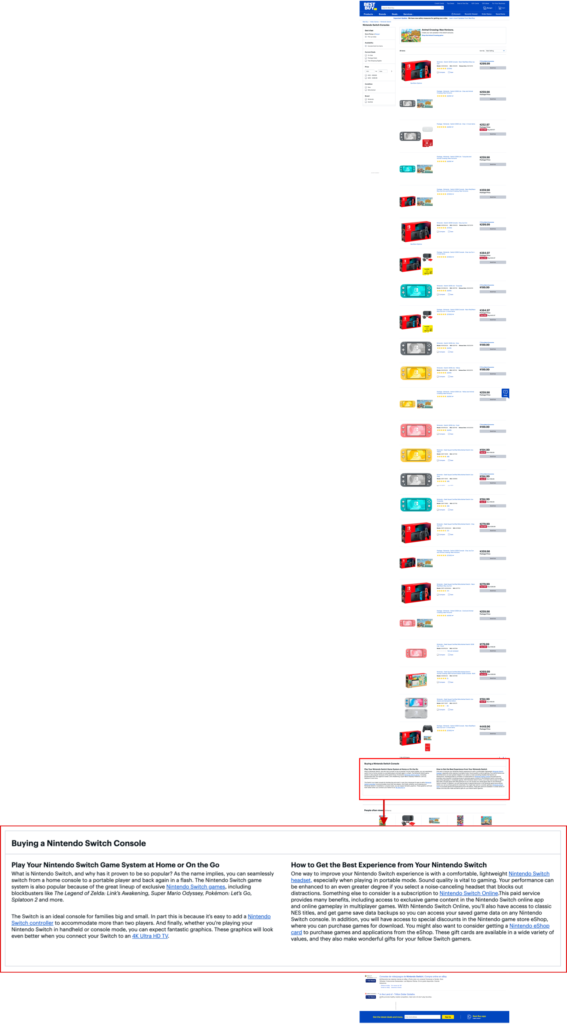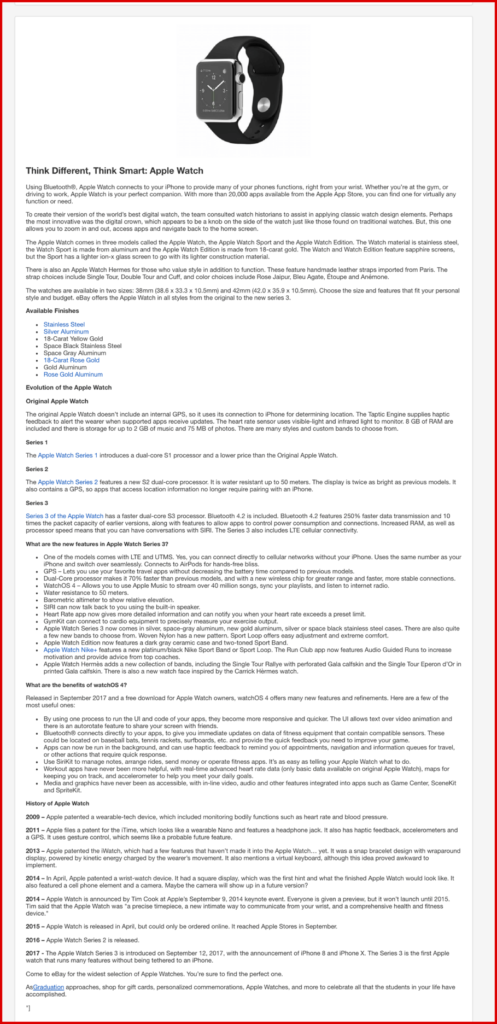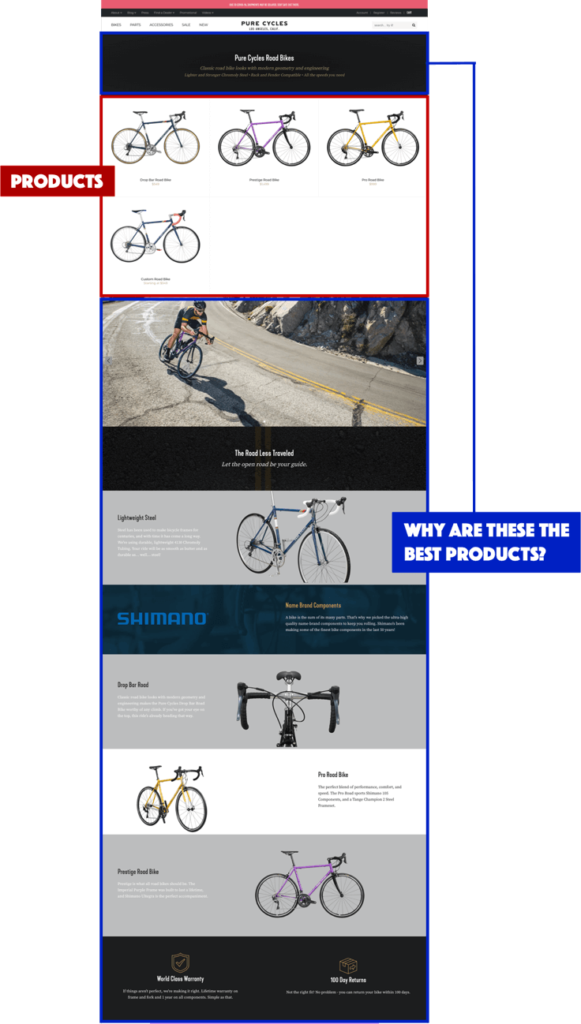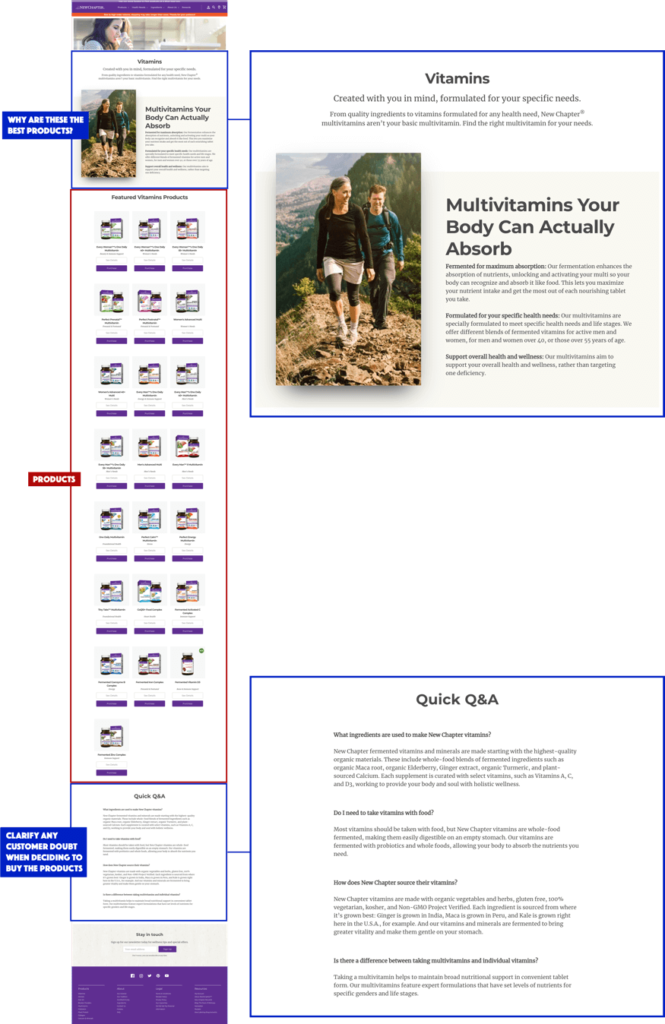There’s an on-going struggle with e-commerce categories pages content. They tend to:
- Target transactional oriented queries that many times have a non-trivial search competition.
- Prioritize the products offering visibility due to its commercial nature.
- Not feature content at all and if they do it, include the content at the bottom of the page, as a tactic to make it relevant to the targeted queries without “messing” with the featured products conversions. However, this content in many cases is also not really aligned with the nature of the page nor formatted in a way to make it easily consumed by the user. It’s just text meant to improve the page relevance.
For an example of the “text at bottom” of an e-commerce category page check out Best Buy’s Nintendo Switch Console page, that has a section for it below the products listings with a heading “Buying a Nintendo Switch Console”.
However the information featured is much more generic, organized in two areas: “Play Your Nintendo Switch Game System at Home or On the Go” and “How to Get the Best Experience from Your Nintendo Switch”, which you would rather expect to see in a “how to” guide.

Adding text at the bottom of e-commerce category pages is rather common, let’s just take a look at:
- Wayfair’s “Laptop & Computer Stands” category page
- eBay’s “Apple Watches” category page
- Costco’s “Televisions” category page
Google stance regarding e-commerce categories pages content
A couple of weeks ago Marie Haynes did a great interview with John Mueller in which she asked about *content featured in category pages* which really resonated (and the reason why I’m writing this post) because of what we just saw above that tends to happen with category pages content, making it a frequent topic in the E-commerce or transactional focused SEO processes I work on: the best way to integrate and optimize content in category pages.
To Marie’s question, John said the following:
The one thing that I notice in talking with the mobile indexing folks is that when the ecommerce category pages don’t have any other content at all other than links to the products then it’s really hard for us to rank those pages. So I’m not saying all of that text at the bottom of your page is bad but maybe 90%, 95% of that text is unnecessary but some amount of text is useful to have on a page so that we can understand what this page is about. And at that point you are probably with the amount of text that a user will probably be able to read as well, be able to understand as well.
Then also John added:
The other thing where I could imagine that our algorithms sometimes get confused is when they have a list of products on top and essentially a giant article on the bottom when our algorithms have to figure out the intent of this page. Is this something that is meant for commercial intent or is this an informational page? What is kind of the primary reason for this page to exist and I could imagine that our algorithms sometimes get confused by this big chunk of text where’d we say oh, this is an informational page about shoes but I can tell that users are trying to buy shoes so I wouldn’t send them to this informational page.
You can read the insightful interview here.
The “giant article at the bottom” might seem a bit of an exaggeration if it wasn’t because there are category pages that feature what could be considered entire articles of 1,380 words at the bottom, like the eBay’s “Apple Watches” category page mentioned above, that includes the evolution of the Apple Watch:

So I can definitely see how featuring the evolution of the Apple Watch in a category page could be a bit confusing… not only to Google but to any user that scrolls enough to read it.
Let’s summarize/analyze what John said:
- For Google *it is* useful to have some amount of text in category pages to understand what the page is about (as with any other page!)
- Nonetheless, if the text featured at the bottom of the category pages is a “giant article”, informational content that is not aligned with the commercial nature/intent of the category page, it can confuse Google.
- Because of the previous point: a lot of the text that is currently added in category pages is unnecessary.
How can we optimize categories pages content in an aligned & natural way
Our goal with category pages should be then to feature information that confirms the features/functionalities/USPs of that particular set of products, clarifies any common doubts about them, informs about any existing offers and why/how the user is in the best place to buy them, as a salesperson would do at a physical store at that point in the customer journey.
To develop this content we can use the questions received via the Website customer support system, the searches performed within the site search functionality, the usual keyword research tools and more targeted tools like alsoasked.com.
This type of information will be:
- Aligned with the page commercial nature/intent
- Optimized to address / target users main queries at that point in the customer journey to increase the page relevance towards them
Like this the content can be featured across the category page to support its goal (rather than challenge it) so there won’t be a need to “decrease its visibility” on purpose, ideally running tests to identify the optimal placement, while making the page more relevant towards its targeted search queries without confusing Google about its intent.
Of course, this is easier said than done due to the high number of category/sub-categories/faceted pages that are worthy to be ranked in e-commerce sites that also tend to offer different lines of products of completely heterogenous nature that rely on the same template and organization for all, which is an important constraint.
However, a balance can be reached with a bit of creativity and flexibility with the UI -have I mentioned how designers and content writers should be our BFF along developers?-.
Let’s go through a few E-commerce Categories pages examples
Let’s take a look at a few e-commerce sites category pages that are featuring content that is aligned with the above mentioned characteristics, since besides featuring the products it features content to:
- Confirm to the user what the products they’re looking at are the best at
- Clarify any doubts/concerns regarding the products shared characteristics and usage
- Inform why they’re at the best place to buy these types of products
Bliss Face Moisturizers category
The Bliss face moisturizers category has what can be described as the “usual” category/listing page template, however, it leaves room at the start to introduce the product characteristics, finishing with an explanation at the bottom too. Note how the placement in this case is at the bottom but not “looking to be hidden” or “overlooked” as usually happens in e-commerce category pages: this content is meant to be read and support the user.

Pure Cycles Road Bikes category
The Pure Cycles Road Bikes category -which ranks in the 1st position for “Chromoly Road Bikes” in the US- features its products at the top, right after an intro with a short description about their unique characteristics:
“Classic road bike looks with modern geometry and engineering.
Lighter and Stronger Chromoly Steel • Rack and Fender Compatible • All the speeds you need”
Descriptive, compelling and attractive copy!
The products are then followed by a very graphical explanation of their characteristics: “Lightweight Steel”, “the bikes components”, “Drop Bar Road”, followed by the shared warranties and conditions.

New Chapter Vitamins category
Here’s a more “traditional” looking category page example that “blends” content: the New Chapter Vitamins category, that ranks in the 3rd position for “fermented vitamins” in the US.
The page starts by introducing their vitamins, explaining what makes them better than others “Fermented for maximum absorption”, “Formulated for your specific health needs”, “Support overall health and wellness”, and then after the products featuring a “Quick Q&A”, answering questions like:
- What ingredients are used to make New Chapter vitamins?
- Do I need to take vitamins with food?
- How does New Chapter source their vitamins?
- Is there a difference between taking multivitamins and individual vitamins?
Which are common questions to ask at that stage of the customer journey when buying vitamins.

See what other sectors are doing with similar pages
Last but not least, it’s highly advisable to take a look at what Websites in other competitive sectors are doing with transactional, category pages that have a similar nature in their own customer journey. For example, how some car rental (or car rental alternative), real estate/properties or food delivery Websites are integrating/blending content within their categories/location pages.
Check out Turo’s location pages, such as Miami, Denver, Las Vegas; or the classic cars, exotic and luxury cars or minivan categories pages:
- They start featuring the top products/services
- Show you what you can enjoy from if you get any of the offered products/services
- They show again products from the top providers/merchants highlighting their testimonials
- They show again more benefits to enjoy from if you use these products
- They highlight previous customers testimonials so there’s no doubt about the quality of the products

This can certainly take more work than featuring 500 or 1,000 words at the bottom of the page about the history or evolution of the products, however, it will be content that will pay off in many more ways: by better highlight the products USPs, by better supporting the customer decision making / conversion process, all while better highlighting their commercial intent.